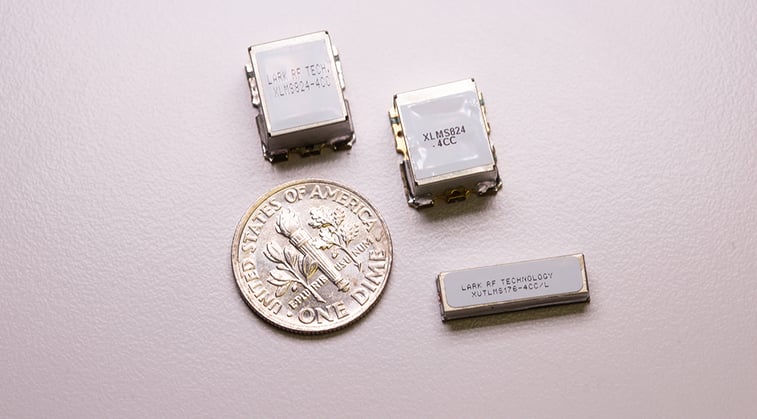Frequency spectrum has long been taken for granted, from the early days of tuning an amplitude-modulated (AM) radio to a favorite sports or news program to making a call on a mobile telephone. Communication happens because radio waves travel across the air from sources to destinations without interference. When subjected to interference, they can be blocked. Radio waves today are used for much more than "just" portable radios and cell phones. Case in point: recent concerns regarding the use of C-band frequencies in Fifth Generation (5G) wireless networks that fall close to the same frequency range as radar altimeters that help safely land large aircraft. Fortunately, proper use of bandpass filters can keep 5G signals from interfering with a C-band radar altimeter and ensure that the plane lands safely.
Too Close for Comfort? Why 5G Can be Challenging Around Airports
Radar altimeters have long been essential sensors onboard commercial and military aircraft, measuring the above ground level (AGL) of the aircraft to assist manned and unmanned landing. A radar altimeter is typically built in one of two formats, transmitting pulses or frequency-modulated continuous-wave (FMCW) signals to the ground, and receiving reflected return signals. The radar can determine the aircraft's AGL by measuring time delays between transmissions and receptions. Radar altimeters often provide data to an automatic landing system (ALS) or other automated systems onboard the aircraft to ensure safe landings in fog, rain, and other hostile weather conditions.
Cellular communications towers for 5G networks operate with frequency spectrum slightly lower than the range of C-band radar altimeters. However, at sufficient power levels, the 5G signals or distortion from those signals can function as noise within the radar altimeters. This noise can degrade landing accuracy from better than ±1 ft. to around ±10 ft., significantly increasing uncertainty in the safety of the aircraft's landing at an airport serviced by 5G cell sites.
In the U. S., the Federal Communications Commission (FCC) is tasked with frequency spectrum management and instituting proper separation between different applications, such as 5G frequency allocations and avionics C-band radar altimeters. The FCC approved the frequency range just below C-band radar altimeters, from 3700 to 3980 MHz, for allocation in 2020 to such applications as mobile communications and fixed-satellite-service (FSS) links from space to Earth. Signal sources from 5G or other applications near in frequency to the radar altimeter band can cause interference, either as fundamental-frequency or spurious emissions when their energy levels are sufficiently high. Through testing, the U. S. Federal Aviation Administration (FAA) has even found that 5G mobile phones used onboard an aircraft can exceed the safe limits of interference for a C-band radar altimeter.
The FAA is working on standards for radar altimeters operating within congested 5G signal environments. Unfortunately, these standards are not expected before October 2022 and will apply only to radar altimeters released after the standards release. The new standards do not apply to radar altimeters already manufactured and installed. There remains a great deal of debate between aviation and communications industries over the significance of 5G signals on the performance of existing C-band radar altimeters. In the meantime, all major U.S. 5G carriers have agreed not to install 5G transmission equipment within two miles of major airports to ensure that radar altimeters are not operating within dense 5G signal environments.
Filtering Safely
C-band radar altimeters are designed to process signals only within that 4200 to 4400 MHz range, ideally with low levels of noise from other signal sources. When the noise levels become too high for a given receiver, it will have difficulty extracting the desired signals—the altimeter's reflected signals from the ground—from the noise. The altimeter will take longer or be unable to process the information about the ground terrain for the automated landing systems. Interference may only occur at a specific altitude and distance from a 5G cell site. Fortunately, a bandpass filter (BPF) with the appropriate passband and performance characteristics can help ensure safe radar altimeter operation by minimizing the threat of interference from 5G and other signal sources in the neighborhood.
 An ideal BPF for a radar altimeter has a passband of 4200 to 4400 MHz with maximum rejection of signals above and below that frequency range. The passband insertion loss should be low to preserve as much of the desired received signal energy as possible. The slopes or transitions from the passband to the lower stopband and the upper stopband should be as sharp as possible, with rejection of at least 50 dB of unwanted signal noise. An important consideration for any filter used with a radar altimeter is minimal propagation delays through a filter so that the unit can accurately calculate AGL. A BPF for C-band radar altimeters should suffer propagation delays of no more than two ns.
An ideal BPF for a radar altimeter has a passband of 4200 to 4400 MHz with maximum rejection of signals above and below that frequency range. The passband insertion loss should be low to preserve as much of the desired received signal energy as possible. The slopes or transitions from the passband to the lower stopband and the upper stopband should be as sharp as possible, with rejection of at least 50 dB of unwanted signal noise. An important consideration for any filter used with a radar altimeter is minimal propagation delays through a filter so that the unit can accurately calculate AGL. A BPF for C-band radar altimeters should suffer propagation delays of no more than two ns.
The filtering needs may vary from altimeter to altimeter, depending upon the aircraft and the operating environment. Filter engineers at Benchmark Lark Technology are happy to assist with specific requirements, such as size, weight, package style, and operating temperature range for a BPF that will help a C-band radar altimeter operate safely in 5G signal environments.
